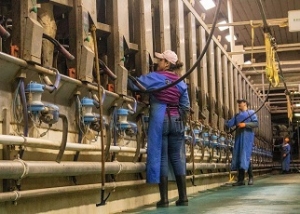Dairy in the World
Australia’s Dairy Problems Persist

According to recent article in Bloomberg, Australia’s share of the world export market dropped from 18% in the 1990s to about 6% in 2018 as Australian producers steadily left the business. Gains made by other major exporters have also worked to whittle away Australia’s share of the global dairy market, said Sarina Sharp, analyst with the Daily Dairy Report.
“Despite high milk prices and decent weather early this season, Australia’s milk output has continued to drop,” Sharp said.
September’s milk collections in Australia fell 6.25% from year-earlier levels to slightly more than 800 million liters, the lowest September milk volume in decades, according to Sharp. Season to date through September, milk production in the country was 6.3% lower than the comparable period last season, compounding a 3.4% decline in the 2021-22 season.
“Production in October likely fell short of last year’s volume as well,” Sharp said. “Heavy October rains led to flooding in eastern Australia, which is home to most of the country’s dairy herd. In Victoria, which accounts for nearly two-thirds of Aussie milk output, some producers were forced to dump milk because their farms were inaccessible, but floodwaters have since started to recede.”
For decades, Australia, which is the driest inhabited continent, has been battling heatwaves and droughts. Between 1997 and 2020, widespread drought affected the country, and the dairy industry, in 27 of those 33 years, according to Bloomberg.
On the upside and unlike in the world’s other large milk-producing regions, feed supplies in Australia are currently abundant and relatively affordable, Sharp said. A recent USDA Global Agricultural Information Network report noted that milk prices in Australia have hit record highs and hay prices are low and feed grain prices are likely to decline, improving margins for dairies.
“Nonetheless, output is in the doldrums and likely to remain there. Labor shortages are so extreme that USDA expects them to hamper milk production in both 2022 and 2023,” Sharp added.
In fact, Australia’s labor shortage is so severe that some dairies have partially or fully transitioned to less labor-intensive beef cattle operations, due in part to record-high beef prices.
“With less milk overall, Australia is devoting a greater share of its output to cheese manufacturing this year, at the expense of butter and powder production, which will likely result in at least modest declines in exports of butter, skim milk powder, and whole milk powder next year,” Sharp said.
The production shift could also chip away at Australia’s share of the world dairy market, softening the impact of weakening overall global dairy demand this coming year, and longer-term allowing U.S. exporters to potentially pick up a share of the world market.






















